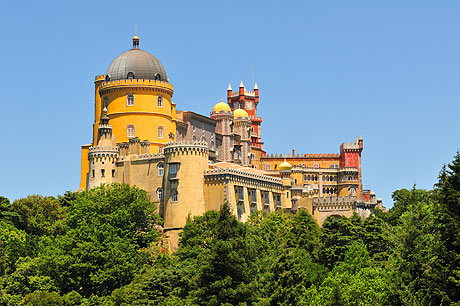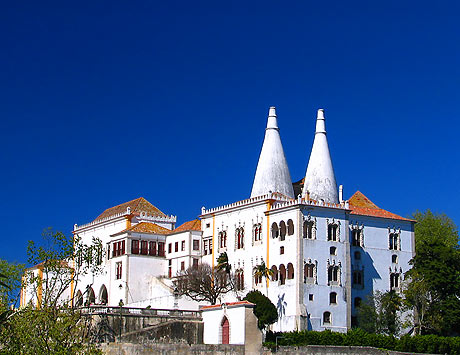Sintra

Sintra is one of the densest trip destinations visitors of Lisbon can explore in the surroundings of the Portuguese capital city. In fact, given the plethora of attractions in Sintra, the town is said to be more of a whole vacation site rather than a day trip destination. Praised by Lord Byron as the most beautiful village in the world and declared a UNESCO World Heritage Site due to its 19th century Romantic architecture and layout, Sintra does not strike only by its architectural and historical patrimony, but also by its nature beauties scattered both in and around the town.
Just as most of the Portuguese ancient settlements, Sintra has fascinated the Romans, the Moors and then the Portuguese nobility, such that, at present, the town is dotted with elegant palaces and exquisite villas, all blending in with the breathtaking nature sights which concur to yield one of the most scenic and aesthetically rewarding towns in Portugal.
Thus, for instance, tourists can direct their attention to highlights like the 14th century Sintra National Palace (Palacio Nacional de Sintra). Located in Praca da Republica (the main public square of Sintra), the Sintra National Palace is an architectural gem which combines the sobriety of the Gothic style with the mild curvatures of the Moorish influences and with the decorative lushness of the Manueline elements.
The Pena National Palace is, however, deemed the most reputed building in Sintra. While surrounded by a fairytale garden populated with exotic species of plants and black swans and decorated with majestic fountains and lakes, the Pena National Palace strikes by its rough medieval look. Indeed, despite the fact it was built no sooner than the mid 19th century, the palace, by its wealth of ramparts, domes and turrets, and well as by the typical drawbridge, calls forth the sobriety of those times when the architectural tendencies dictated the construction of fortress-like residences. The interior of the palace does not fall short of its exterior architectural and decorative merits.
 Pena National Palace in Sintra
Pena National Palace in Sintra Other two notable fantastic palaces in Sintra refer to the Seteais Palace and to the Monserrate Palace. They are both must-visits for holidaymakers of Lisbon, given their age and architectural merits alike. Tourists can also delight in exploring the dreamlike gardens which surround the palaces, paying attention to both their vegetal patrimony and to the decorative highlights. The Regaleira Palace is yet another sight not to be missed out by visitors of Sintra, in particular due to its magical garden which surprises by its wealth of symbolic decorations while being majestically pegged out by lakes, fountains and grottoes through which winding alleys meander mysteriously.
Other notable landmarks of special tourist interest refer to the 8th century Castle of the Moors (Castelo dos Mouros), which provides the best panoramic views of the town, and to the Challet Biester, an exquisite villa once featured in a film by Roman Polanski. The Toy Museum and the local Modern Art Museum are also well worth a visit. The Moorish Fountain and the Sabuga Fountain are two of the most remarkable fountains in Sintra, highly prized for the way they brighten up the architectural landscape of the town.
The Adraga Beach is the finest stretch of sand tourist can sunbathe on while in Sintra, whereas one of the most stunning nature beauties refers to Cabo da Roca, a 140 meter high rock which springs from the sea yielding a dramatic view pegged out by an old lighthouse. Adding the fact Sintra is located in Parque Natural de Sintra-Cascais, one can easily understand this fairytale town is an ideal starting point for the pursuits of people keen on nature explorations.
In Sintra there are two tourist information offices visitors can rely on in order to learn the tourist essentials of the town and orient better while discovering this greatly prized Portuguese destination. One is located in Praca da Republica, and the other on Avenida Miguel Bombarda.
- Name:
- Sintra
- Address:
- Sintra, Portugal
 Sintra National Palace
Sintra National Palace